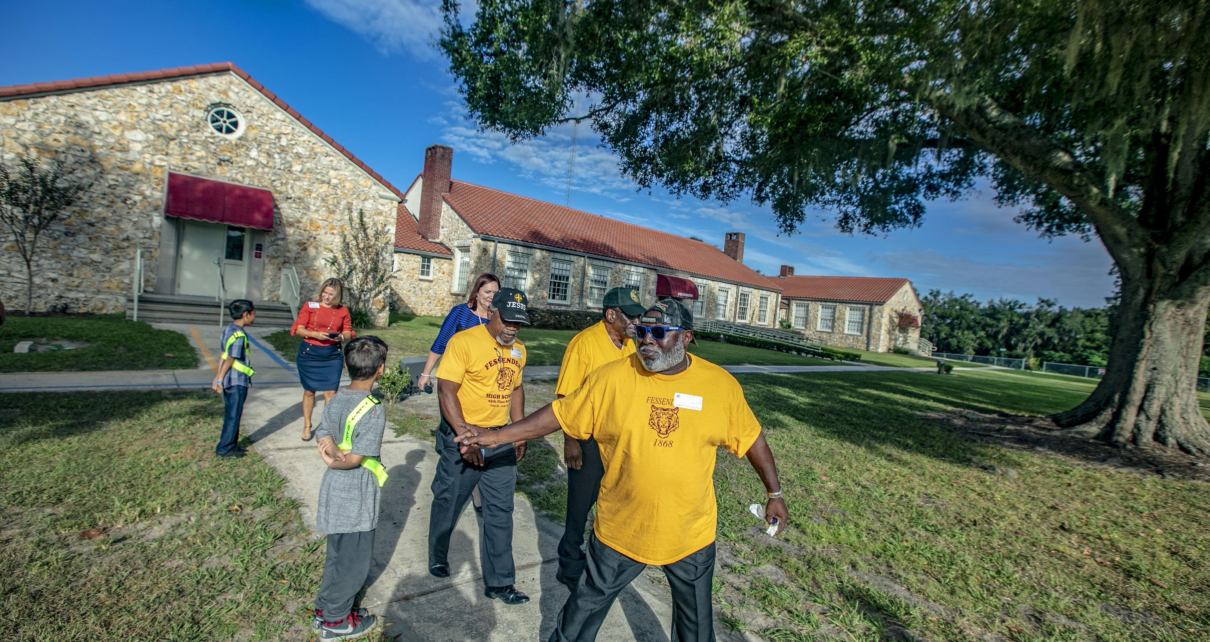A small one – room log cabin – the states first school for black students – seemed destined for failure under Florida’s segregation movement in the years after it opened in 1868.
Though President Abraham Lincoln had freed slaves at the end of the Civil War, white Florida Lawmakers fought to deny black children a public education.
But thanks to gritty persistence and the financial help many philanthropists, including steel magnate Andrew Carnegie, the Union School (as it was called in 1868), would not only survive but grow into one of the states finest institutions for black students.
It later would become the Fessenden Academy, a model private school to which children from around the country would come by train to get a first – class education, including top – notch vocational training.
The private boarding school north of Ocala weathered the suspicious 1914 disappearance of John Wiley, one of the school’s most successful and famous leaders. The school eventually became one of Marion County’hs public schools in 1951.
On Friday, on the scenic grounds of what now is called Fessenden Elementary School, at 4200 NW 89th Place, near the communities of Zuber and Martin, dozens of graduates, school officials and dignitaries gathered to celebrate the school’s rich 150 – year history.
Fessenden is the oldest continuously operated school originally for black students in Florida and one of the oldest in the nation. In 1994 Fessenden Elementary was named to the National Register of Historic Places.
“We don’t have another school with this type of history”, said Kevin Christian, the school districts communications director. “Eighth Street Elementary does, obviously, but not for as many years as Fessenden. The fact that it has been used continuously for 150 years for the purpose, education, I think sets it apart”.
Gilbert Raiford, 87, was a 1950 graduate of Fessenden Academy just before the private school was sold to the Marion County School District.
Raiford said Fessenden was an elite school, with most all of its graduates landing college scholarships. Raiford who has since earned two doctorate degrees from the University of Chicago, also attended and taught at New York University.
“It was a residential school, attracting students from all around the world, “ Raiford said of the academy. “Everyone had to stay on campus during the last year of school to prepare them socially to leave home and go to college. It was a great experience.
The land for the school dates back to 1855, when President Franklin Pierce granted a land purchase to Edmond Martin of South Carolina to launch Sugar Hammock Plantation.
After President Lincoln’s Emancipation Proclamation, which freed slaves, Frank Cain donated one acre of plantation land to build the first 16 – foot by 16 – foot log cabin. The construction was financed by Thomas B. Ward. It was Florida’s first school for blacks and became known as the Union School.
By 1890, wealthy philanthropist Ferdinand Stone Fessenden of Boston, Massachusetts, came to Marion County for health reasons,. One day he stumbled across the aging log cabin. He decided to provide funds, land and leadership to improve the Union School.
A year later, Fessenden helped build a two – story schoolhouse that was stocked with books, maps and desks. The school, by many accounts, was better equipped than many rural public schools for white children.
By 1893, Fessenden had planned to deed the school to Marion County Public Schools. But, after talking with school officials, and based on the anti – black school movement in Tallahassee, he chose to find another operator, the American Missionary Association of New York, historic documents state.
A year after Fessendens death in 1899, the school was renamed the Fessenden Academy and Industrial School.
That was when John Wiley, a Fisk University graduate, took over the school and led Fessenden into the spotlight. By then, there were 250 students. Of those, 50 students – or about 20 percent – were full – time boarders.
Under Wiley’s leadership, the school added many programs, from carpentry, blacksmithing and agriculture to sewing cooking and housework.
In 1907, the school received $8,000 in grants and donations, including $6,500 grant from Andrew Carnegie. Adjusting for inflation, Carnegie’s donation would be equivalent to $180,000 today.
The money paid for 37 acres, a women’s dormitory, more classrooms, a library and dining hall. At the time, the school was for grades 9-12.
One day while Wiley was visiting Ocala, he went missing. He was presumed dead and foul play was suspected. His car was found in Ocala, but his body was never found.
More than 1,000 black youth graduated during Wiley’s tenure at the school,.
By 1922, the school name was shortened to Fessenden Academy.
After years of up and downs, John A. Buggs, Marion county’s leader of the NAACP, took over as director in 1941. Buggs was known for his fight for civil rights and even held voter rights drives at the school.
By 1951, after Marion County Public Schools opened its first high school for black students, the American Missionary Association closed Fessenden Academy and the local School District purchased the property. The district continued operating the school as Fessenden High School.
In 1970, during the early years of integration, Fessenden became a middle school. Three years later, the school was renamed Fessenden Elementary School. Rev. Eugene Broxton became the first elementary principal.
Union School/Fessenden Timeline
1855: President Franklin Pierce grants a land purchase (where Fessenden Elementary School is today) to Edmond Martin of South Carolina.
1860: Col. John Marshal Martin of South Carolina becomes manager of Sugar Hammock Plantation on the site.
1861 – 1865 Civil War
1863: Emancipation Proclamation, which freed slaves, was issued by President Abraham Lincoln.
1868: Frank Cain donated one acre of the plantation land to build a 16-foot by 16-foot log cabin. The construction was financed by Thomas B. Ward. It was Florida’s first school for blacks and became known as the Union School.
1877: First Black teacher was appointed.
1886: Union School enrollment reached 300 students.
1890: Ferdinand Stone Fesssenden of Boston, Massachusetts, provides funds, more land and leadership to improve Union School.
1891: Fessenden helps build a two story schoolhouse, stocked with books, maps and desks.
1893: Fessenden, who was planning to deed the school to Marion County, discovered the local district had low views about educating black children.
1896: Fessenden decides to turn over sponsorship to American Missionary Association of New York.
1899: Fessenden dies; John Wiley a Fisk University graduate, took over the school.
1900: The school was renamed Fessenden Academy and Industrial School.
1903: Wiley leads Fessenden into the spotlight. By then there were 240 students, and 20 percent as full-time boarders. The school added many programs, from carpentry, blacksmithing and agriculture, to sewing, cooking and housework.
1907: Wiley received $8,000 in grants and donations, including $6,500 grant from Andrew Carnegie. The money sourced a new women’s dormitory. Besides new classrooms, a library and dining hall were constructed. The grades 9-12 school was on 37 acres.
1915: Wiley goes missing and is presumed dead of foul play. His car was found in Ocala, but his body was never found. More than 1,000 black youth graduated during his tenure at the school.
1922: Name shortened to Fessenden Academy.
1941: After years of ups and downs at Fessenden, John A Buggs, Marion County’s leader of the NAACP, assumes the director’s role. Fessenden was then a secondary school and community center.
1951: After Marion County Public Schools opened ts first high school for black students, the American Missionary Association closed Fessenden Academy and the local School District purchased the property. That was when Fessenden High School was born.
1970: During the early years of integration, Fessenden becomes middle school.
1973: The school is renamed Fessenden Elementary School. Rev. Eugene Broxton becomes first elementary principal.
1988-92: Educator Bobby James who would later become the county’s first black school board member, was named principal.
1992-2002: Loretta Jenkins became the first female principal at the school.
1994: Fessenden is designated a historic school by the National Register of Historic Places.
2002-04: David Ellers becomes the first white principal at Fessenden.
2018: 150th anniversary.
Educator Bobby James, who became the county’s first black School Board member in 2002, and will retire in about a month was named principal. He served from 1988-92.
Using a cane during the ceremonies on Friday, James, 71, walked to a monument that was erected in Fessenden’s honor years ago. James used over sized scissors to cut the 150th anniversary ribbon.
“Fessender School was a school that thought the unthinkable and did the impossible for 150 years”, James said.
Loretta Jenkins became the first female principal at the school in 1992 and served a decade.
“How proud I am to be part of this very significant and monumental occasion”, Jenkins said. “This is truly a milestone in the pages of history of Marion County”.
David Ellers became the first white principal at Fessenden in 2002. Ellers said he is proud to be part of the school’s rich history.
“Kids came from all over to this school”, Ellers said of the history. “And they graduated and went to elite colleges”.
Whitfield Jenkins, a 1959 graduate of Fessenden High, said he is proud to have attended the school. He said for more than a century Fessenden’s leaders fought hard for racial equality and made an impact.
Whitfield Jenkins said that in the 1967 – 68 school year, he became the first black teacher to teach at a formerly white school in Marion County. He was hired at Osceola middle school.
Johnnie Grimes, 80, a 1957 graduate of Fessenden High and the president of the Fessenden School Alumni Association, said the group is still selling engraved bricks to be placed near the Fessenden memorial marker at the front of the school.
The 4×8 inch bricks were sold $50 each, the 8×8 inch bricks were sold $75 and the 12×12 bricks were sold $100 each.
Graves said the association has sold 118 bricks and needs to sell 320 or so more to complete the project.
Lacy Redd, the current Fessenden Elementary principal, introduced two students who read a brief history of the school of Friday.
Redd said that every day the children read the Pledge to Allegiance and the school mantra, which, she said, she knows would have made “Mr. Fessenden” proud: “I am somebody. I was somebody when I came here, I will be a better somebody when I leave. I am powerful and I am strong. I deserve the education I get here. I have things to do, people to impress ad places to go”.
“I can’t tell you how wonderful it is to see every child say that every morning”, Redd said.
Originally Written By: Joe Callaham






